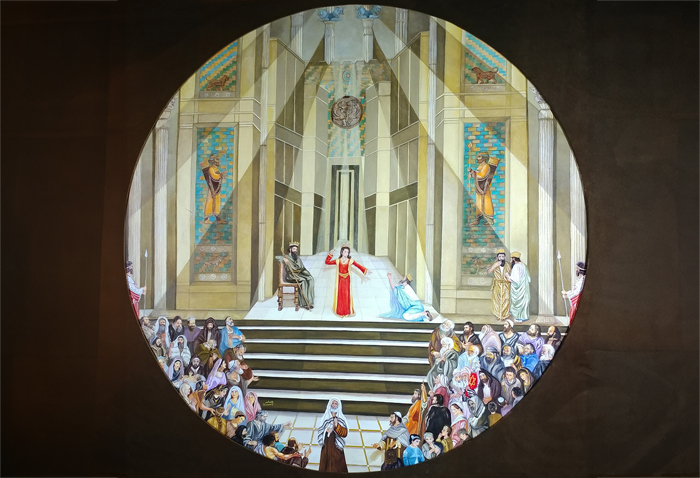 “Epiphany of Queen Esther” by Los Angeles-based artist Shahin Dardashti (shahinart.com).
“Epiphany of Queen Esther” by Los Angeles-based artist Shahin Dardashti (shahinart.com). This time of year, many non-Persian Jewish friends remind me that as an Iranian Jew, “my holiday” is just around the corner. It’s true that Persian Jews feel a little possessive of Purim. Esther and Mordechai are even said to be buried in a tomb in what is now the city of Hamadan in Western Iran.
But several years ago, one of my Ashkenazi friends offered a bold declaration during a Shabbat meal: “Tabby,” he announced, “Purim isn’t only a Persian Jewish holiday. It belongs to all of us, because all of us were there in Persia with you.”
For a moment, a hush fell over the table as guests looked squarely in my direction for any semblance of offense. In an age when wokeism has hijacked much of our mental processing, was this Ashkenazi man, who had wished me a “Good Shabbos,” and who sat within arms’ reach of a pungent bowl of German-style brined herring, appropriating my history as a Persian Jew?
Could he actually claim such ownership of Purim? And what was next? Ashkenazi Jews chasing one another with scallions during the “Dayenu” recitation of the Passover seder, in true Persian and Afghan Jewish-style? (One can only hope.)
Everyone waited for my reaction. After a few seconds, I smiled, slammed my hand on the table (the herring was a safe distance away) and shouted, “Of course! You were there as well!”
I immediately understood what my friend meant. And in this week’s column, I want to share three Purim-related arguments with non-Iranian Jewish readers that will hopefully help them view Purim through a new lens:
First, there is a possibility that they, too, can trace their ancient lineage back to the Jews of the Persian Empire, even if their descendants were Ashkenazim. Second, every Jew today owes ancient Persian Jewry a debt of gratitude for having essentially saved Judaism and Jewish learning. And third, at a time when the regime in Iran has never been more dangerous and provocative against the Jewish state, it was precisely the ancient Persian empire that also played a role in saving Judaism.
Jews settled in the land of Persia (Iran) on four different occasions: in 609-611 BCE, following the first Exile of 722 BCE, caused by the Assyrians; in 538 BCE, following the second Exile of 586 BCE, caused by the Babylonians; in 70 CE after the destruction of the Second Temple by the Romans; and in the 17th century as a result of the Spanish Inquisition and dispersion of the Jews into the Ottoman Empire and later into Iran.
After the second Exile, when Nebuchadnezzar II’s armies destroyed the First Temple in 586 BCE, most of the Jews were taken into Babylonian captivity as slaves. There were no Ashkenazim, Sephardim or Mizrahim: only Jews. That’s what my friend meant when he said that we were all in the ancient Persian provinces together.
While there were still some Jews left in Judea, there were some who went to Egypt, Elephantine Island, and other North African locations. However, the Persian Empire gained administrative control over Judea. The Jews who returned to Jerusalem after the construction of the Second Temple eventually fell under Greek and then Roman control and, later, were dispersed throughout Europe and the territories that eventually became known to us as Eastern Europe.
When you’re Jewish, it’s all in the family. We truly are one big, extended family.
The second Exile could have spelled the end of Judaism. “Everything was lost, including [nearly] all of the scrolls and vessels,” Dr. Houman M. Sarshar told me. Sarshar is an independent scholar with numerous publications about the history of Jews in Iran, including “Esther’s Children: A Portrait of Iranian Jews” (editor) and “Jewish Communities of Iran: Entries on the Judeo-Persian Communities of Iran” (editor).
Cyrus the Great, founder of the Persian Empire, conquered Babylonia and performed a historic miracle for the Jews within his jurisdiction: He proclaimed religious freedom throughout his lands, freed the Jews from slavery and actively allowed them to return to Jerusalem.
But everything changed for the Jews in Babylonian captivity just 47 years after the First Temple fell. Cyrus the Great, founder of the Persian Empire, conquered Babylonia and performed a historic miracle for the Jews within his jurisdiction: He proclaimed religious freedom throughout his lands, freed the Jews from slavery and actively allowed them to return to Jerusalem.
Cyrus even gave the Jews the choice to either stay or go back to Jerusalem. Although he had promised to rebuild the Temple, unfortunately, he died before realizing this dream. It was achieved later, between 521-516 BCE, when the Persian king Darius I rebuilt the Second Temple (paid by the Persian empire’s treasury) and sent back the articles taken from the Temple. Incidentally, Darius’ son, Xerxes, is Ahasuerus, whom Queen Esther marries in Megillat Esther.
This is why I love to describe the non-Jewish Cyrus and Darius, who have a special place in the hearts of Iranian Jewry, as two of the world’s earliest Zionists.
Even the Book of Ezra references Cyrus the Great, and Cyrus’ magnanimity allowed Jews to return to Jerusalem in less than five decades (the prophet Jeremiah had declared the Exile would last 70 years). Of course, not all Jews returned. Many stayed within Persian territories, and that is why, considering the first Exile annexation, about 2,600 years later, they still consider themselves Iranian Jews today.
I hope readers remember this incredible history the next time they meet an Iranian Jew, whether in Israel, Toronto, America or hopefully one day, back in Iran.
Other ancient Persian leaders helped Jews in extraordinary ways. With the blessing of the Persian King Artaxerxes I or II (in the Book of Ezra, it is not clear which), Ezra and his followers were sent back to rebuild the city of Jerusalem.
Ezra was a Jewish scribe and priest who was born in Babylonia after the First Temple was destroyed. The level of Jewish assimilation and intermarriage that Ezra witnessed in Jerusalem caused him to tear his clothes and mourn.
Back then, Judaism was a sacrificial religion, until Ezra made Judaism a scribal religion by replacing the “sacrifice” with “prayers” Yet the laws were still an oral tradition until Yehuda Hanasi, who first codified the oral interpretations of the earlier rabbis (the tannaim) in six sections called the Mishnah in 200 CE Hanasi was the last of the tannaim.
In Jerusalem, Ezra was later joined by Nehemiah, whom the Persian king Artaxerxes I/II appointed as governor of Jerusalem, and after many years, Jewish communities again flourished there during the Second Temple period.
Persian Jewish history is rife with paradoxes: For every Haman or rapidly antisemitic ayatollah, there was a Cyrus or a Darius.
The Persians saved the Jews a second time by giving shelter to the amoraim (Talmudic commentators) in their academies, who compiled the Babylonian Talmud. The late Dr. Habib Levy, the legendary Iranian Jewish historian who was born in 1896 in Qajar-era Iran, and painstakingly wrote the first Iranian Jewish history book in Persian, often emphasized the role of Persian Jews in Judaism. This book was later abridged and translated into English as “The Comprehensive History of the Jews of Iran: The Outset of the Diaspora.”
In his book, Levy claims that the Babylonian Talmud should have been called the “Iranian Talmud,” based on the fact that one-third of its vocabulary is in Middle Persian (called Pahlavi). It should be mentioned that the Jews at that time spoke Eastern Aramaic.
Sarshar emphasized the Persian connection with regard to Ezra and other ancient Jewish leaders so passionately I felt compelled to challenge him: Were Ezra, Nehemiah and other Jews who were born in Babylonia truly Persian or Babylonian? Weren’t they simply Jews who were in Babylonian exile for a few decades before returning to Israel?
“That’s an ongoing argument, and people generally fall in one side or the other and there is little hope of converting any of them,” he said. “My position is that they were Persian/Iranian Jews. And there are reasons for this, one of which being the complicated problem that always comes up in antisemitic discourse whereby Jews are never considered citizens of their countries and thus presumed spies/agents of some conspiracy cabal to betray the lands in which they live (e.g. the Dreyfus affair in France). So as far as I’m concerned, they were all Iranian Jews.”
Sarshar then made a fascinating observation: “Another argument is the current state of Iranian expats in the U.S.,” he said. “It’s been just over 40 years since we all left Iran, and well over 25 years since everyone considers themselves and their children Americans. So why would it be any different 2,500 years ago? Especially since 2,500 years ago (psychologically), 40 years was a much longer span of time than it is today.”
If I could meet Ezra today, I would ask him if he considered himself a Persian Jew. I would also hand him a bright green scallion and invite him to my Passover seder.
If I could meet Ezra today, I would ask him if he considered himself a Persian Jew. I would also hand him a bright green scallion and invite him to my Passover seder.
Dr. Lior Sternfeld, co-author of “Jews of Iran: A Photographic Chronicle,” told me there is no question as to “the centrality of Iranian Jewry in preserving and developing Judaism.” Iran, Sternfeld said, “was the most important political power of that time, and one that had closest relations with the Jewish community all over the region.”
If you’re bewildered to learn that Iran once had the best relationship of any country with Jews worldwide, don’t blame the Purim liquor; it’s the truth.
Of course, as Jews, we must never forget that nations, whether ancient or modern, may offer us blessings, but ultimately, we remain on earth because of a millennia-old promise that G-d made to our forefathers. The ancient Jews viewed even the worst disasters, such as the fall of the First Temple, with remarkable clarity, because they saw the hand of G-d in history. They also saw those who controlled them, even the Babylonians, as necessary conduits to a greater purpose that G-d had in mind for them.
This year, it will be extremely difficult to celebrate Purim with a heart filled only with joy, especially in Israel. But may we always possess the resilience and the clarity of our ancestors, who understood precisely why Judaism is so precious.
In fact, their clarity reminds me of an 1899 short essay by Mark Twain, in which he wrote, “All things are mortal but the Jew; all other forces pass, but he remains.”
Purim Sameach.
Tabby Refael is an award-winning writer, speaker and weekly columnist for The Jewish Journal of Greater Los Angeles. Follow her on X and Instagram @TabbyRefael







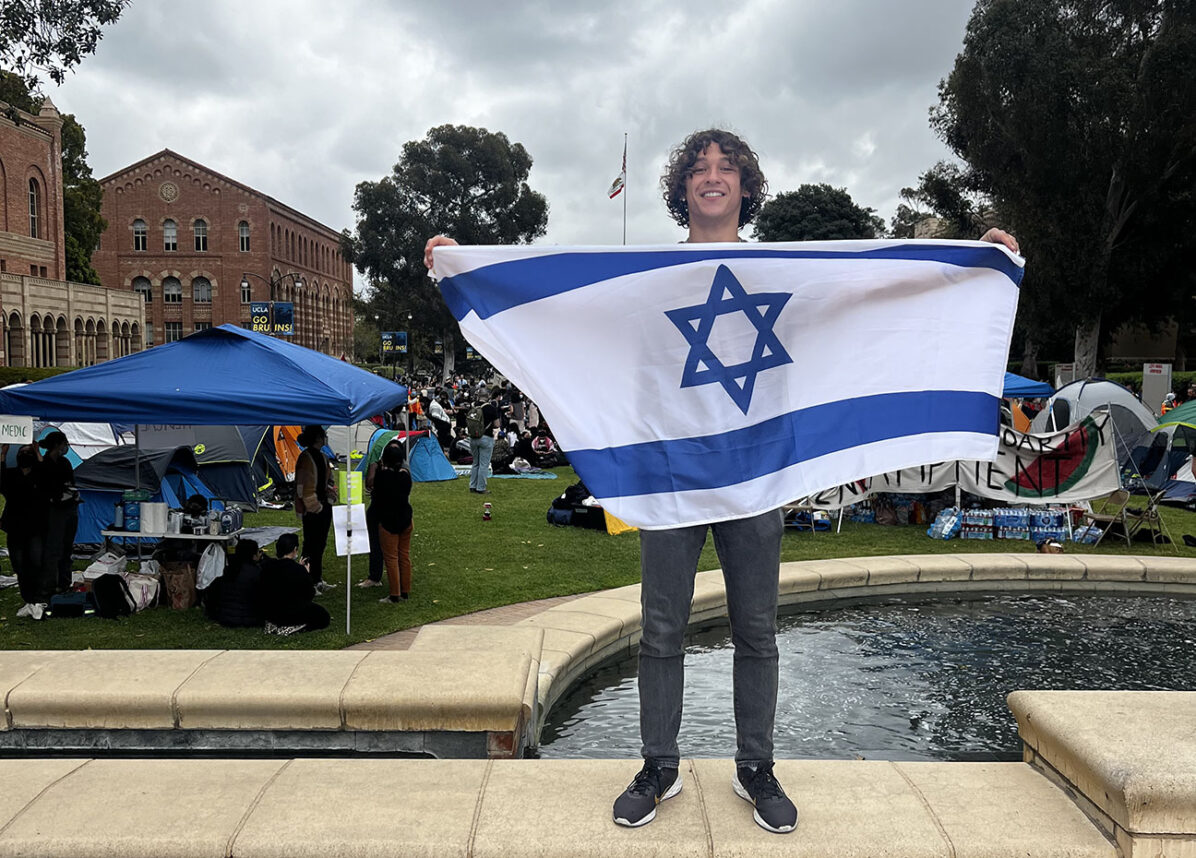


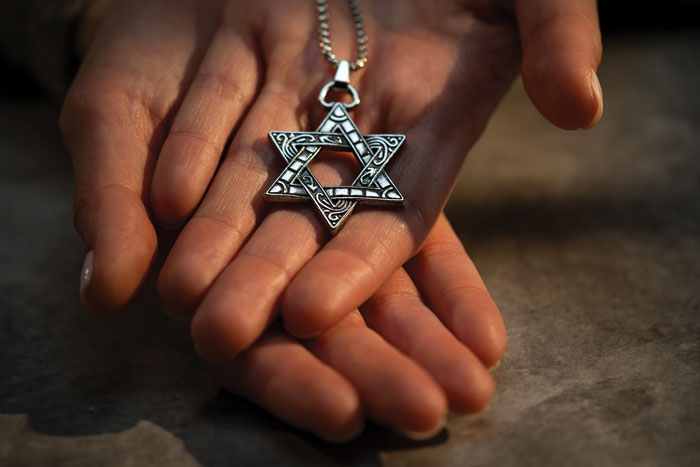

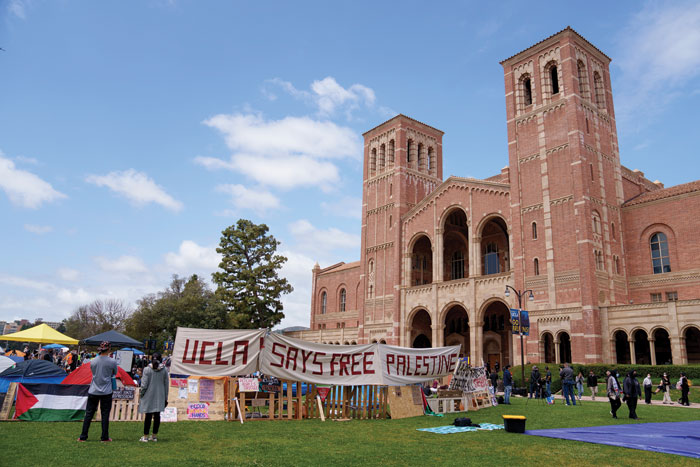


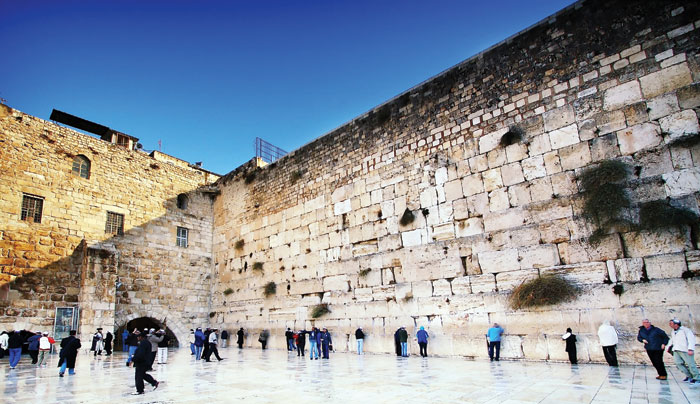
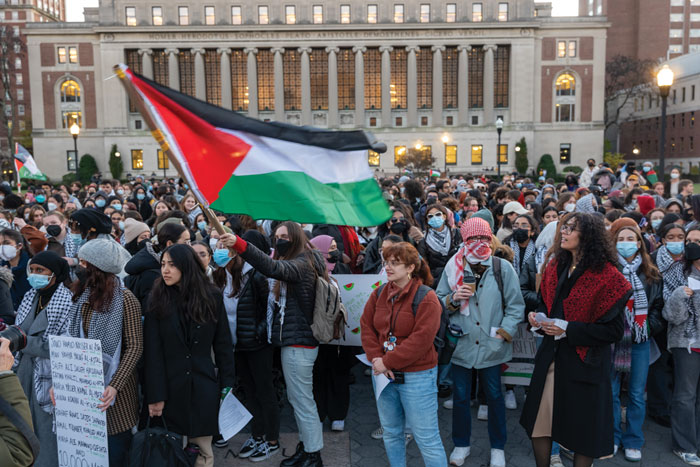
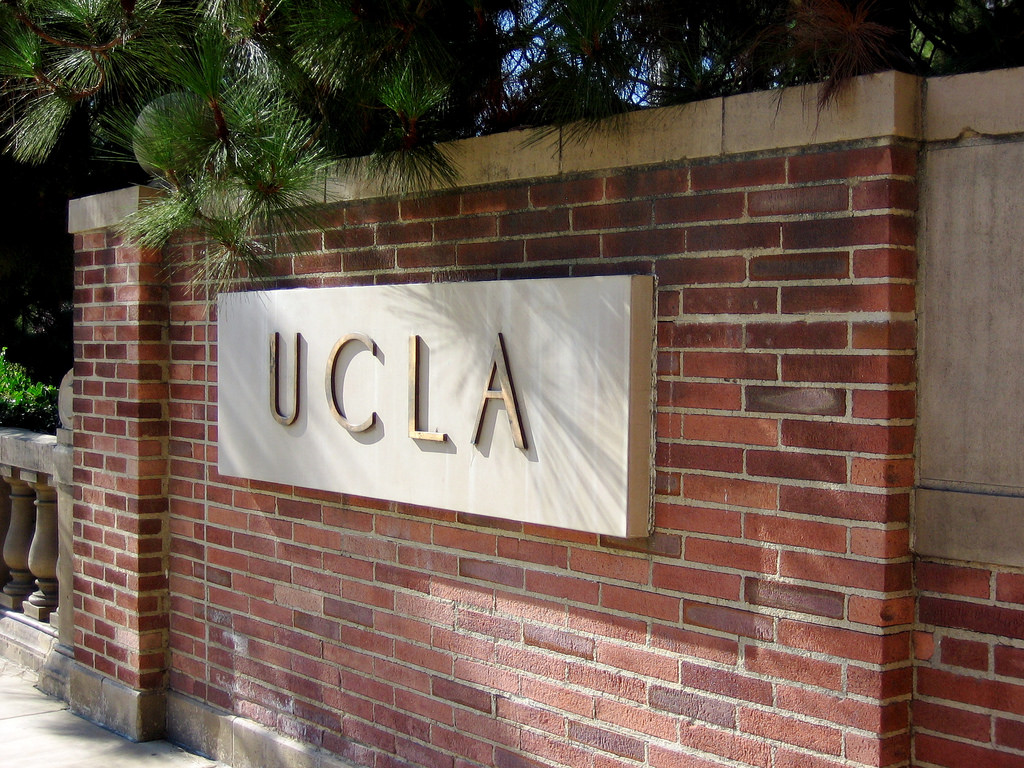





 More news and opinions than at a Shabbat dinner, right in your inbox.
More news and opinions than at a Shabbat dinner, right in your inbox.